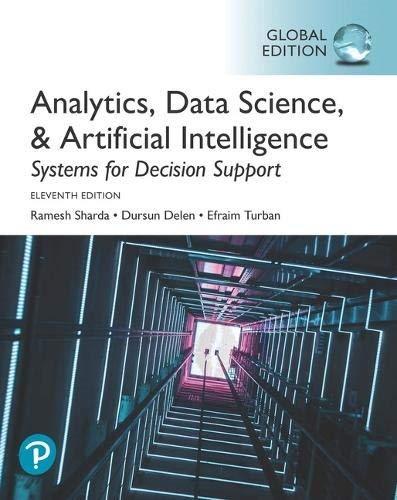Question
T oday, US citizens trudging through a freezing Minnesota winter can indulge their cravings for summer-fresh raspberries. Europeans who are thousands of miles away from
Today, US citizens trudging through a freezing Minnesota winter can indulge their cravings for summer-fresh raspberries. Europeans who are thousands of miles away from North America can put Mexican mangoes in their breakfast cereal. Japanese shoppers can buy radishes that were grown from seeds cultivated in Oregon. Globalization of the food industry, falling trade barriers, and the formation of regional trading blocs make it possible for people to choose from produce grown all over the world. Unfortunately, these forces have also made it more likely that consumers will contract illnesses from food-borne pathogens.
In recent years, several outbreaks linked to the burgeoning global trade in produce have made headlines. One serious case occurred when 2,300 people were victims of a parasite called Cyclospora that had hitched a ride on raspberries grown in Guatemala. Outbreaks of hepatitis A and Salmonella from tainted strawberries and alfalfa sprouts, respectively, have also sickened consumers. The outbreak of severe acute respiratory syndrome (SARS) killed hundreds and sickened hundreds more, mainly in China, Singapore, and Canada. Some scientists believe a fair amount of those cases might actually have been cases of H5N1, also called Avian (bird) flu. Avian flu is particularly virulent and can cross barriers between species. It is most likely transmitted through the handling of poultry and poor sanitation.
Although health officials say that there is no evidence that imports are inherently more dangerous, they do cite several reasons for concern. For one thing, produce is often imported from less-advanced countries where food hygiene and sanitation are lacking in important ways. Also, some microbes that cause no damage in their home country can be deadly when introduced to other countries. Finally, the longer the journey from farm to table, the greater is the chance of contamination. Just consider the journey taken by the Salmonella-ridden alfalfa sprouts: The seeds for the sprouts were bought from Uganda and Pakistan, among other nations, shipped through the Netherlands, flown into New York, trucked to retailers all across the United States, and then purchased by consumers.
Incidences of food contamination show no sign of abating. Since the passage of NAFTA, cross-border trade in food among Canada, Mexico, and the United States skyrocketed. Meanwhile, federal inspections of US imports by the Food and Drug Administration (FDA) have declined. Increasing imports have strained the US food-safety system, which was built 100 years ago for a country contained within its own borders. Yet the US Congress continues to try to advance the cause of greater food safety when it comes to trade. Changes that have been considered include giving the FDA mandatory recall authority, increasing the frequency of food inspections, and requiring food safety plans for food makers.
Although it isn't feasible for the United States to plant FDA inspectors in every country, options are available. The US Congress could further tighten the ban on importing fruit and vegetables from countries that fail to meet expanded US food-safety standards. Better inspections could be performed of farming methods and government safety systems in other countries. Countries that blocked the new inspections could be forbidden to sell fruit and vegetables in the United States. The World Health Organization (WHO) also proposes new policies for food safety, such as introducing food irradiation and other technologies. The WHO believes the most critical intervention in preventing food-borne diseases is promoting good manufacturing practices and educating retailers and consumers on appropriate food handling.
Global trade in food is worth more than $1 trillion annually. The global supply chain for food today resembles a massive web of product flows among countries. Experts worry that this may mean a decreasing ability to track contaminated food or products causing foodborne illness. This can be especially complex when a raw food is imported, processed into an intermediate product, exported to a country that then processes it into a finished product (or perhaps into another intermediary product even), before it is sold to another country that processes it into a finished product. Such networks in the global food trade can impede the key task of quickly determining the origin of any food contamination when it occurs.
ASSIGNMENT:
Q1. How do you think countries with a high volume of exports to the United States, such as Mexico, would respond to stricter food-safety rules? Do you think such measures are a good way to stem the tide of food-related illnesses? Why or why not?
Q2. Some people believe that free trade agreements force consumers to trade the health and safety of their families for free trade. What are the benefits and drawbacks of putting food safety regulations into regional trade pacts?
Q3. The lack of harmonized food-safety practices and standards is just one of the challenges faced by the food industry as it becomes more global. What other challenges face the food industry in an era of economic integration and opening markets?
Q4.Provide suitable conclusion as well.
Q5.Refrences(atleast 4)
minimum 500 words.
Step by Step Solution
3.55 Rating (148 Votes )
There are 3 Steps involved in it
Step: 1
Q1 Countries with a high volume of exports to the United States such as Mexico would likely respond to stricter foodsafety rules with a mixed reaction On one hand stricter regulations may increase the ...
Get Instant Access to Expert-Tailored Solutions
See step-by-step solutions with expert insights and AI powered tools for academic success
Step: 2

Step: 3

Ace Your Homework with AI
Get the answers you need in no time with our AI-driven, step-by-step assistance
Get Started


